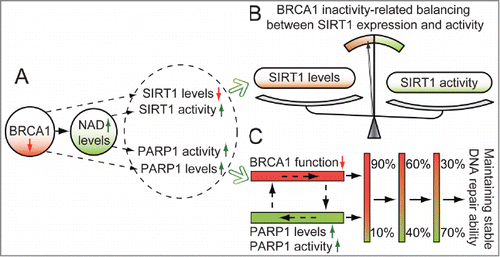Two decades ago, interest was sparked by the discovery of the first breast cancer susceptibility gene, BRCA1, and it was confirmed that germline mutations of BRCA1 have markedly elevated risks of 56–80% for breast cancer and 15–60% for ovarian cancer.Citation1
BRCA1 is a tumor suppressor gene with multiple protein interaction domains that is involved in numerous cellular pathways, including DNA damage repair, cell cycle progression, chromatin remodeling, and protein ubiquitylation.Citation2 Notably, research has confirmed that BRCA1 is an important transcriptional regulator, and BRCA1 depletion shows changes to approximately 7% of the mRNAs expressed in cancer cells.Citation2 Moreover, our recent study also indicated that there are wide ranges of transcriptional regulation, epigenetic patterns, and metabolic differences between BRCA1 dysfunction and the basal phenotype.Citation3–6
Nicotinamide adenine dinucleotide (NAD), as well as its precursors, derivatives, and metabolic enzymes, has recently drawn much attention as regards a variety of biological functions including transcriptional regulation, DNA repair, cell cycle progression, metabolism, lifespan, and cell death.Citation7 Typically, (i) sirtuin 1 (SIRT1) is an NAD-dependent protein deacetylase; (ii) poly(ADP-ribose) polymerase-1 (PARP1) as a sensor of DNA damage catalyzes the transfer of ADP-ribose units from NAD to target proteins; (iii) nicotinamide phosphoribosyltransferase (NAMPT) is the rate-limiting enzyme for NAD biosynthesis, which together comprise a system of regulatory networks, termed the ‘NAD World’, that maintains the balance of cellular metabolism and has essential roles in tumor development and therapy.
Interestingly, emerging evidence has suggested possible links among BRCA1, NAMPT, SIRT1 and PARP1. For example, (i) BRCA1 is responsible for NAMPT-mediated NAD synthesis, and NAD can feedback-activate BRCA1 expression;Citation6 (ii) NAD serves as the common substrate independent of its redox-carrier function by SIRT1 and PARP1;Citation3,5 (iii) BRCA1 is an important modulator of cellular stresses such as metabolic stress, oxidative stress, and replication stress. Similarly, SIRT1 is a key metabolic sensor in response to cellular stress;Citation5 (iv) BRCA1 is a positive regulator for PARP1 levels and NAD-dependent PARP1 activity, and the high efficiency of PARP1-mediated NAD consumption can feedback inhibit BRCA1 transcription;Citation3 (v) BRCA1 has been shown to serve as a positive regulator of SIRT1 by binding to the promoter region – decreased levels of SIRT1 are triggered by BRCA1 inactivation, and may reduce the intracellular NAD consumption, which plays a partial role in the elevated NAD levels.Citation6 Therefore, the emerging picture from these studies prompted us to evaluate a possible link between BRCA1 and NAD World. It seems beneficial for the understanding of BRCA1-related biological processes from NAD World aspects, such as (i) aberrant proliferation which is known to be critical for cancer progression. It has also been shown that the loss of function of the BRCA1 plays an important role in promoting cancer cell proliferation and survival. Likewise, NAD-dependent signaling pathways are widely involved in cell proliferation and metabolism;Citation6 (ii) BRCA1 inactivation not only increases reactive oxygen species generation, but also activates protective autophagy. SIRT1 can positively regulate autophagy under oxidative stress. In this regard, SIRT1 expression and imbalance in its activity may be involved in BRCA1-related oxidative stress and autophagy;Citation5 (iii) Endoplasmic reticulum (ER) stress signaling plays an important part in the induction of BRCA1 expression. However, ER stress can be attenuated by a SIRT1-dependent mechanism. Therefore, BRCA1-related elevated levels of SIRT1 may resist the adverse effects of ER stress.Citation5 As summarized in , proposed model of the role of BRCA1 in the regulation of SIRT1 and PARP1. Overall, this may improve our understanding of the basic molecular mechanism underlying BRCA1- and NAD-related biological processes.
Figure 1. Proposed model of crosstalk among BRCA1, SIRT1 and PARP1. (A) BRCA1 inactivation may regulate SIRT1 and PARP1 levels, and induce an increase in NAD-mediated SIRT1 and PARP1 activity. (B) the model shows a significant effect of BRCA1 in the maintenance of SIRT1-related biological processes. (C) a proposed model to maintain stable BRCA1 and PARP1-related DNA repair ability.

References
- Millot GA, et al. Hum Mutat 2012; 33: 1526–37; PMID:22753008; http://dx.doi.org/10.1002/humu.22150
- Dacheux E, et al. PLoS One 2013; 8: e67313; PMID:23805307; http://dx.doi.org/10.1371/journal.pone.0067313
- Li D, et al. Cell Cycle 2014; 13: 3442–9; PMID:25485588; http://dx.doi.org/10.4161/15384101.2014.956507
- Li D, et al. Oncotarget 2014; 5: 1315–25; PMID:24675476
- Li D, et al. Sci Rep 2014; 4: 6666; PMID:25323003; http://dx.doi.org/10.1038/srep06666
- Li D, et al. Cell Cycle 2014; 13: 2564–71; PMID:25486197; http://dx.doi.org/10.4161/15384101.2015.942208
- Chiarugi A, et al. Nat Rev Cancer 2012; 12: 741–52; PMID:23018234; http://dx.doi.org/10.1038/nrc3340
